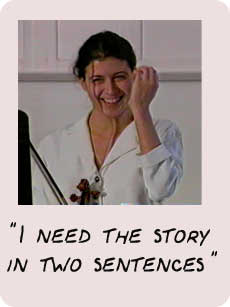|
|
Katalina Groh, Larry Prusak: Some of the world's leading thinkers |
| The film-maker as storyteller: Katalina Groh |
 |
III.
TELLING DIFFERENT KINDS OF STORIES
I tell stories every day. Thatís all I do. Whether Iím playing producer, or playing director, or writer, or telling stories to try to get people to put up money for a film. And sometimes my audience will listen to me for about thirty seconds before they decide whether they want to hear any more. And other times, I know Iíve got them. We have an hour and a half meeting. And theyíve just had lunch, theyíre just very relaxed. Itís completely different kind of storytelling to those different audiences. I could have all the time in the world to sit all night long with my editor if I choose to, and thatís one kind of storytelling. |
| STORYTELLING
IS INTERACTIVE
How does one learn how to do it? Itís what Steve was saying earlier, itís a matter of practice. When it doesnít go right the first time, or the tenth time, then of course, you have to keep trying. Much of it is discovering where to begin the story. I discovered that the story shouldnít be begun at the chronological beginning. You have to figure out very quickly, what does this person care about? Because he doesnít care about what I care about, and thatís o.k. So what does this person care about? And then based on that, you tell your story. And itís a very intuitive thing, and itís practice. You have to practice, because knowing what might just barely spark their interest, and how you begin a story so that as soon as possible, you become interactive, As Larry Prusak said, itís not like the Monty Python approach to learning, where you open up someoneís head, and you pour the information in. Youíre waiting for him to respond, to come back. Because the sooner the audience responds, whether itís hundreds of people watching a video at the same time, or whether Iím speaking to an individual, the sooner the audience experiences the story and really feels something, the better the story is. Thatís the objective. And thatís always our objective: to have the person really experience something. A STORY TO RAISE MONEY: A STORY IN TWO SENTENCES Telling stories to try to get people to put up money for a film. is the most important part of what I do, since none of this would get done without the money. That one minute conversation that I have, and the story that I tell him, is one of the most important stories that I have to know how to tell. For instance, on a different project that Iím doing right now, I had a phone call with the president of HBO. He is the kind of person whoís actually going to put the video out there before an audience, so that very many people will get to see it. So in many ways he is the most important person for us, since the video is not just something weíre going to watch ourselves, obviously. And thatís what happened with the HBO executive. The fact that he took my call is something in itself. I had all these notes. I had all these things I planned to tell him and we were on the phone for 15 seconds but he wanted to know the story in two sentences. And I just stopped and I started to laugh. And I said, ďWellÖĒ And he goes, ďIs that the beginning of the first sentence?Ē (Laughter) And I laughed, because I didnít have it in two sentences. He goes, ďI believe you have a good story. I know you have a good story. But call me tomorrow at noon, when you have it in two sentences. O.k.?Ē (Laughter) And I said, ďIíll talk to you at noon.Ē Participant: How about negotiating with him? For four sentences? (Laughter) Katalina Groh: No, no, not with a distributor. And he was right, because he hears stories all the time. He cares about good stories. He looks for good stories. But he wants to know he apologized the next day. I had my two sentences. They were pretty good. We ended up talking for an hour on the phone. So my first two sentences were the right ones. And we Participant: What were the two sentences? (Laughter) Katalina Groh: Itís actually what end up being on the front of the box cover. It is ďItís very American story about what it means to be from some place else.Ē Participant: Thatís nice! Another participant:
Itís one sentence.
|
| Books and videos on storytelling *** In Good Company : How Social Capital Makes Organizations Work by Don Cohen, Laurence Prusak (February 2001) Harvard Business School Press *** The Social Life of Information, by John Seely Brown, Paul Duguid (February 2000) Harvard Business School Press *** The Springboard : How Storytelling Ignites Action in Knowledge-Era Organizations by Stephen Denning (October 2000) Butterworth-Heinemann *** The Art of Possibility, a video with Ben and Ros Zander : Groh Publications (February 2001) |
| The views expressed on this website are those of the authors, and not necessarily those of any person or organization |
| Site optimized in 800x600: webmaster CR WEB CONSULTING |
|
|
|
|